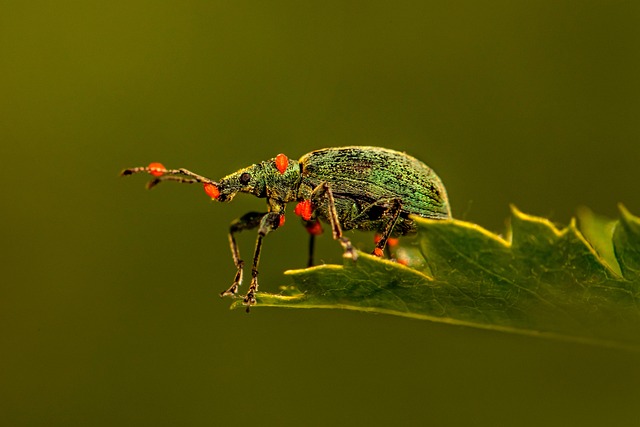Stinging pest control requires understanding insect behaviors: bees favor nectar/pollen, wasps prefer sweet substances and open containers. Key strategies include sealing entry points, cleanliness, and removing attractants. Regular inspections are vital for identifying nests. Professional stinging pest control services use specialized gear and expertise for safe nest removal, minimizing risks. Proactive maintenance like sealing gaps, securing garbage, trimming shrubs is crucial. These professionals employ advanced treatments, equipment, and regulations for effective, efficient control. A strategic, year-round approach focusing on thorough maintenance and monitoring, with expert advice from stinging pest control services, ensures a pest-free environment.
Stinging pests, such as bees, wasps, and hornets, can transform outdoor spaces into hazardous areas. Understanding these common types and their behaviors is the first step towards effective management. This article offers professional advice on reducing attractants and providing comprehensive solutions for stinging pest control services. We explore prevention tactics to create an uninviting environment, discuss professional interventions, and share long-term strategies for maintaining a pest-free haven.
Understanding Stinging Pests: Common Types and Their Behavior
Stinging pests, such as bees, wasps, and hornets, are a common concern for many homeowners and businesses. Understanding these insects is the first step in effective stinging pest control services. Each species has unique behaviors and preferences that influence their attraction to certain areas or structures. For instance, bees are primarily drawn to sources of nectar and pollen, often found in lush gardens or nearby fields. Wasps, on the other hand, tend to be attracted by sweet substances, strong scents, and open containers that serve as easy access points for them to build nests.
Knowing their behavior allows for targeted strategies in pest management. Preventative measures include sealing entry points, maintaining a clean environment, and removing potential food sources or water collections. Regular inspections are crucial to identifying nest locations and understanding the scope of the infestation. Professional stinging pest control services employ specialized equipment and knowledge to handle these insects safely, ensuring that any nests are removed or treated effectively while minimizing risks associated with their stings.
Creating an Uninviting Environment: Prevention Tactics
Creating an environment that discourages stinging pests like bees, wasps, and hornets is a proactive step in stinging pest control services. Start by identifying and eliminating potential nesting sites around your property. These pests are drawn to spaces that offer easy access and shelter, such as gaps in walls, attics, or even under deck structures. Regularly inspecting your home and yard for these entry points and sealing them off can go a long way in deterring them.
In addition, maintaining a clean and clutter-free outdoor space is essential. Pests are attracted to sources of food and water, so keeping garbage bins secure and promptly removing any fruit or nectar-rich flowers can significantly reduce their interest in your property. Regularly trimming trees and shrubs also helps disrupt potential nesting grounds, making your home less appealing to these stinging intruders.
Professional Interventions: Effective Stinging Pest Control Services
Professional interventions play a crucial role in effectively managing and controlling stinging pest populations. Stinging pest control services offer specialized treatments tailored to address specific pests like bees, wasps, and hornets, ensuring both safety and efficiency. These professionals utilize advanced equipment and industry-leading chemicals to eliminate nests while minimizing environmental impact.
Engaging the services of experts ensures a thorough understanding of local regulations and best practices for stinging pest management. With their expertise, they can identify even the most subtle signs of infestation, targeting problem areas accurately. This proactive approach not only saves time but also reduces potential risks associated with do-it-yourself methods, making it an ideal solution for homes, commercial spaces, or agricultural settings.
Long-term Strategies: Maintenance and Monitoring for a Pest-free Space
To achieve and maintain a space free from stinging pests, long-term strategies centered on meticulous maintenance and monitoring are essential. Regular inspections are key to identifying potential entry points or signs of pest activity early on. This proactive approach allows for swift action using appropriate methods, like sealing gaps with caulk or employing targeted treatments.
Implementing year-round prevention measures is crucial. This includes keeping areas clean, eliminating standing water that could attract mosquitoes, and managing vegetation to prevent pests from finding shelter or hiding places. Working with professional stinging pest control services can provide tailored solutions and expert advice for ongoing protection, ensuring a comfortable and safe environment.
In conclusion, effectively managing stinging pests requires a multi-faceted approach. By understanding their behavior, creating an uninviting environment through prevention tactics, and considering professional interventions like specialized stinging pest control services, you can significantly reduce attractants and maintain a pest-free space. Long-term strategies, including regular maintenance and monitoring, are also crucial to preventing future infestations. Remember, with the right combination of methods, achieving and maintaining a peaceful outdoor environment is well within reach.
